- Home
- About
- Map
- Trips
- Bringing Boat West
- Migration West
- Solo Motorcycle Ride
- Final Family XC Trip
- Colorado Rockies
- Graduates' XC Trip
- Yosemite & Nevada
- Colorado & Utah
- Best of Utah
- Southern Loop
- Pacific Northwest
- Northern Loop
- Los Angeles to NYC
- East Coast Trips
- Martha's Vineyard
- 1 Week in Quebec
- Southeast Coast
- NH Backpacking
- Martha's Vineyard
- Canadian Maritimes
- Ocracoke Island
- Edisto Island
- First Landing '02
- Hunting Island '02
- Stowe in Winter
- Hunting Island '01
- Lake Placid
- Chesapeake
- Provincetown
- Hunting Island '00
- Acadia in Winter
- Boston Suburbs
- Niagara Falls
- First Landing '99
- Cape Hatteras
- West Coast Trips
- Burning Man
- Utah Off-Roading
- Maui
- Mojave 4WD Course
- Colorado River Rafting
- Bishop & Death Valley
- Kauai
- Yosemite Fall
- Utah Off-Road
- Lost Coast
- Yosemite Valley
- Arizona and New Mexico
- Pescadero & Capitola
- Bishop & Death Valley
- San Diego, Anza Borrego, Joshua Tree
- Carmel
- Death Valley in Fall
- Yosemite in the Fall
- Pacific Northwest
- Utah Off-Roading
- Southern CA Deserts
- Yosemite & Covid
- Lake Powell Covid
- Eastern Sierra & Covid
- Bishop & Death Valley
- Central & SE Oregon
- Mojave Road
- Eastern Sierra
- Trinity Alps
- Tuolumne Meadows
- Lake Powell Boating
- Eastern Sierra
- Yosemite Winter
- Hawaii
- 4WD Eastern Sierra
- 4WD Death Valley +
- Southern CA Deserts
- Christmas in Tahoe
- Yosemite & Pinnacles
- Totality
- Yosemite & Sierra
- Yosemite Christmas
- Yosemite, San Diego
- Yosemite & North CA
- Seattle to Sierra
- Southwest Deserts
- Yosemite & Sierra
- Pacific Northwest
- Yosemite & South CA
- Pacific Northwest
- Northern California
- Southern Alaska
- Vancouver Island
- International Trips
- Index
- Tips
- Books
- Photos/Videos
- Search
- Contact
Catavina , Mexico
Thursday, February 21, 2019 - 12:30pm by Lolo
106 miles and 2.5 hours from our last stop - 1 night stay
Travelogue
 Hotel Mision CatavinaAfter leaving San Quintin, we had intended to stop at “La Lobera,” a sea lion sanctuary about a half hour south. However, the rains had made the 3-mile dirt access road to the sanctuary a muddy mess. The deep tire tracks, which showed vehicles turning around, made us decide not to take the chance. Besides, we had already seen so many sea lions in La Jolla. Still, it would have been nice to see.
Hotel Mision CatavinaAfter leaving San Quintin, we had intended to stop at “La Lobera,” a sea lion sanctuary about a half hour south. However, the rains had made the 3-mile dirt access road to the sanctuary a muddy mess. The deep tire tracks, which showed vehicles turning around, made us decide not to take the chance. Besides, we had already seen so many sea lions in La Jolla. Still, it would have been nice to see.
Continuing on, we stopped to get gas in the small village of El Rosario, the last gas until Jesus Maria, 360 km south. Every guidebook insists the necessity of doing this. It was also our first mercado (market) stop. Like most roadside stores in northern Baja after the rains, the parking lot was a muddy mess. However, since I had not allowed Herb to bring more than the allowable beer across the border (rules are rules), he was going to get a 12-pack of Tecate no matter what it took.
 Looking out from the old Catavina cave painting museumThere wasn’t much on the narrow, winding road between El Rosario and Catavina - just llanta (tire) shops, cacti, junk yards, cow crossing signs, more cacti, billboards no longer advertising anything, and dilapidated buildings covered in graffiti. Throughout the drive, on any surface that could be written on were the words “Morena, La Esperanza de Mexico” (The Hope of Mexico), which I assumed to be a politician running for office. One more thing about the cow crossing signs. Everyone of them had the cows wearing shiny red shoes. I have no idea why, even after googling it.
Looking out from the old Catavina cave painting museumThere wasn’t much on the narrow, winding road between El Rosario and Catavina - just llanta (tire) shops, cacti, junk yards, cow crossing signs, more cacti, billboards no longer advertising anything, and dilapidated buildings covered in graffiti. Throughout the drive, on any surface that could be written on were the words “Morena, La Esperanza de Mexico” (The Hope of Mexico), which I assumed to be a politician running for office. One more thing about the cow crossing signs. Everyone of them had the cows wearing shiny red shoes. I have no idea why, even after googling it.
As we approached Catavina, the road led us through beautiful boulder fields, sprinkled with cacti and other desert plants, another example of the natural beauty to be found in Baja.
As we entered town there were a couple of pickup trucks selling gas out of tanks in the back of their trucks to those foolhardy enough not to have gassed up in El Rosario (in the north) or Jesus Maria (in the south).
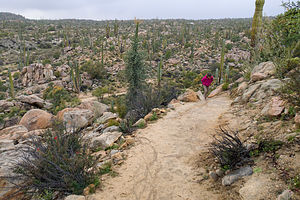 Hiking up to the Catavina cave paintingsRather than stop to see the cave paintings, we decided to check into our hotel first. I had reserved a room at the Hotel Mision Catavina, owned by the same people that owned the Hotel Mision Santa Maria in San Quintin.
Hiking up to the Catavina cave paintingsRather than stop to see the cave paintings, we decided to check into our hotel first. I had reserved a room at the Hotel Mision Catavina, owned by the same people that owned the Hotel Mision Santa Maria in San Quintin.
Like the Mision Santa Maria, the hotel was lovely - nice updated rooms, a courtyard with a fountain, and a nice restaurant. In addition, this hotel had a courtyard pool, but unfortunately the weather was much too cold to enjoy it. At $85 American dollars a night, it was a bit pricier than its sister hotel, but it was the only game in town. It was still cheap by American standards for a hotel of this caliber. Except I was annoyed that I did have to pay 30 pesos for an hour of internet.
We then set out to see the nearby are the Catavina Cave Paintings (Pinturas Rupestres), the most accessible cave paintings in Baja. The directions said to look for the blue INAH sign at kilometer 76 on the east side of Mexico 1. It didn’t look like an entry there, so we continued on for another 100 meters or so and pulled onto a dirt road marked Museo and campground.
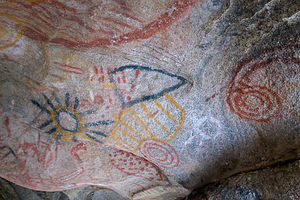 1,000 year old Cochimi cave paintingsThe Museo turned out to be a dilapidated and crumbling geodesic dome, interesting, but long past its days of being informative. We continued down the dirt road through the campground past fields of cacti and other desert plants. There wasn’t a camper to be seen. We still were unsure if this was the place to see the cave painting. We hoped not, because with all the boulders on the hill, we wouldn’t know which one to look in.
1,000 year old Cochimi cave paintingsThe Museo turned out to be a dilapidated and crumbling geodesic dome, interesting, but long past its days of being informative. We continued down the dirt road through the campground past fields of cacti and other desert plants. There wasn’t a camper to be seen. We still were unsure if this was the place to see the cave painting. We hoped not, because with all the boulders on the hill, we wouldn’t know which one to look in.
Realizing we were in the wrong place, we got back on Mexico 1, turning off this time, as instructed, at the INAH sign. This was obviously the right place. There were information signs, which would have been informative if we knew Spanish, as well as an extremely well-marked trail, delineated by white stones, leading up a hill to a series of boulders.
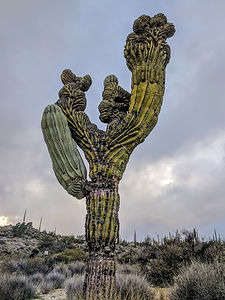 Anatomically correct cactusWe waited in the car for a few minutes waiting for the rain to stop, before proceeding up the trail to the cave, an easy 10-minute walk.
Anatomically correct cactusWe waited in the car for a few minutes waiting for the rain to stop, before proceeding up the trail to the cave, an easy 10-minute walk.
The paintings are tucked inside a small cave at the top of a hill. They were fabulous - colorful yellow, red, and black geometric designs, abstract shapes, and a predominant sun, created by the Cochimi people about a 1,000 years ago. We sat in the cave for a few minutes, just us, and the spirits of the artists that adorned this cave so long ago.
That night we had dinner in the cozy hotel dining room. I was quite pleased with my planning so far, having found some pretty nice oases of civilization along the way.
Description
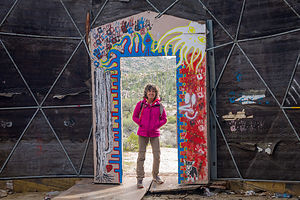 Old Catavina cave painting museumCatavina is a small town in the middle of the desert with a mini market and one hotel. There is no longer a gas station, but in its place are several pickup trucks selling barrel gas. Because there is not much between El Rosario and Guerrero Negro, it is a popular overnight stop for people passing through.
Old Catavina cave painting museumCatavina is a small town in the middle of the desert with a mini market and one hotel. There is no longer a gas station, but in its place are several pickup trucks selling barrel gas. Because there is not much between El Rosario and Guerrero Negro, it is a popular overnight stop for people passing through.
However, beyond its convenience as a stopover, Catavina has much to offer on its own. The terrain around the small town is a photographer's paradise, with its striking boulder fields sprinkled with cacti and desert plants.
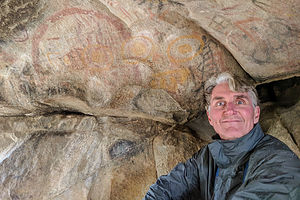 Herb enjoying the artAlso nearby are the Catavina Pinturas Rupestres, the most easily accessible cave paintings in Baja. To find them, at kilometer 76 look for the INAH sign on the east side of Mexico 1. Park your car hear and follow the well-marked trail up the hill to the paintings - about a 10 minute walk. Their are informational signs along the way explaining the history and significance of this site. Unfortunately, they were all written in Spanish.
Herb enjoying the artAlso nearby are the Catavina Pinturas Rupestres, the most easily accessible cave paintings in Baja. To find them, at kilometer 76 look for the INAH sign on the east side of Mexico 1. Park your car hear and follow the well-marked trail up the hill to the paintings - about a 10 minute walk. Their are informational signs along the way explaining the history and significance of this site. Unfortunately, they were all written in Spanish.
The paintings are tucked inside a small cave at the top of a hill. The drawings, done in yellow, red, and black minerals, depict a sun, geometric designs, and other abstract shapes. They were believed to have been created about a 1,000 years ago by the Cochimi people.
- ‹ previous
- 3 of 14
- next ›
Catavina location map in "high definition"
Javascript is required to view this map.

If you make this trip again, there is a little Curio shop maybe 5-10 miles north of Catavina - turn onto the road next to the shop/lot and drive out the dirt and rocky road about 9 miles - the now non-operational onyx mine, El Marmol, is out there with an old onyx schoolhouse and a very interesting grave yard with onyx headstones. There are onyx rocks all over the place - I always gather up a few for my garden.
Your trip notes are fantastic, I have done many of the same activities.
Thanks La Pulga for your comment,
Apologies for the late response, but our system was down for a bit.
We will definitely check out the El Marmol onyx mine on our next trip down Baja.
Best, Herb